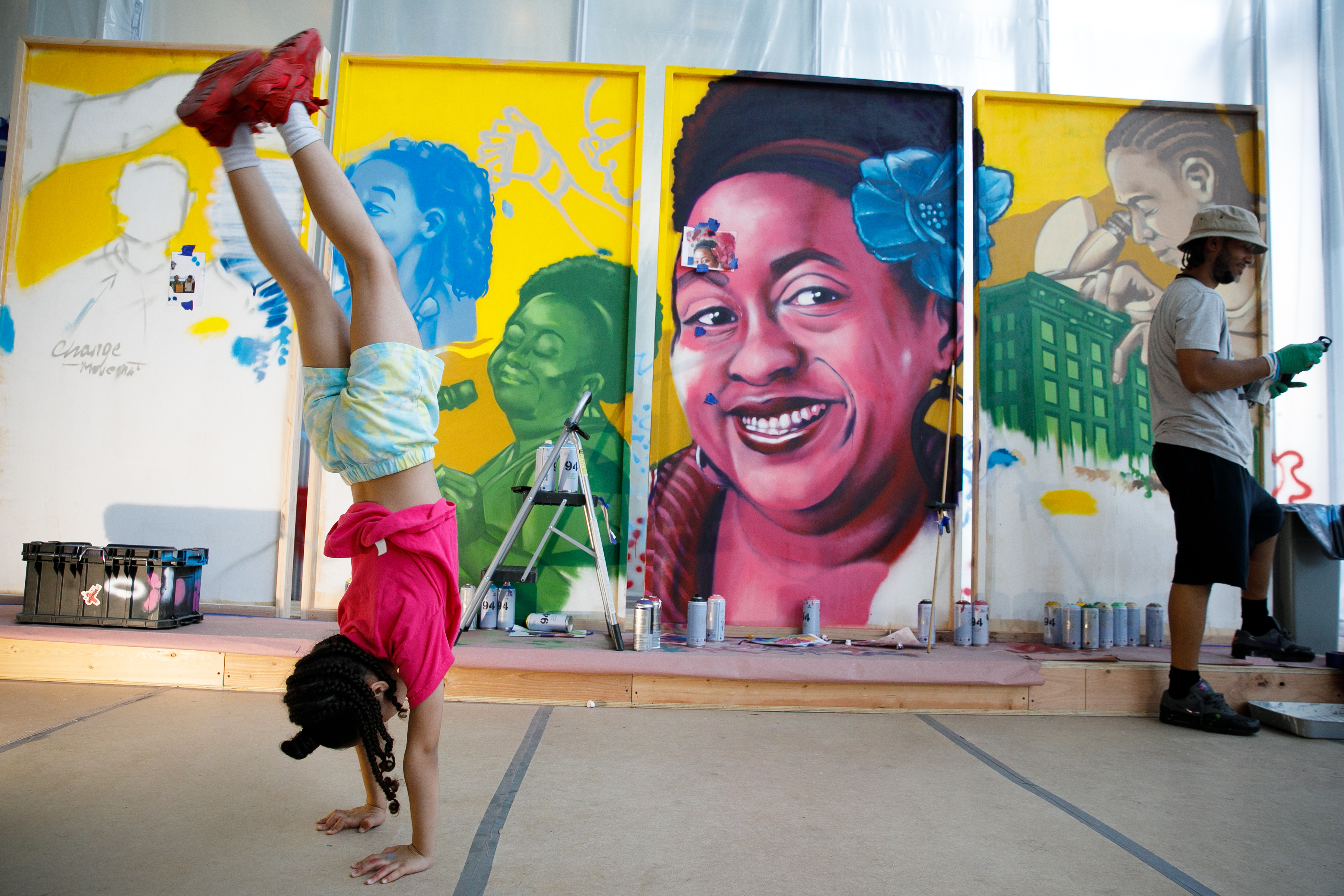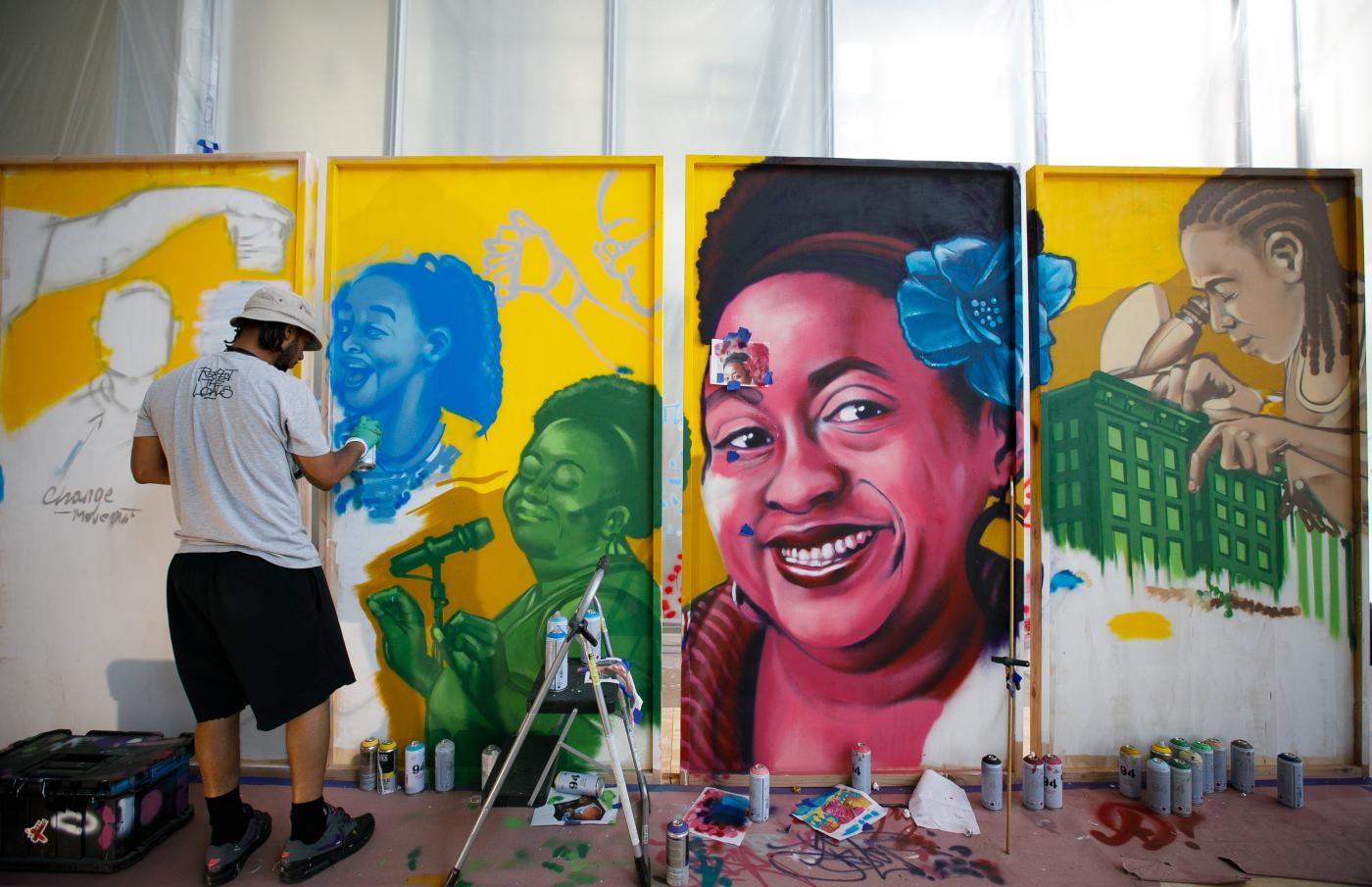Walk by Columbia’s Zuckerman Institute, and you may notice a colorful new addition: a mural spray painted by local artist DISTER RONDON. The culmination of months of work and years of planning, this piece illustrates new connections between scientists in the Institute and neighbors in the surrounding communities. Paula Croxson, PhD, associate director of public programs, sat down with DISTER RONDON, the artist, to talk about the intent behind the work and the process of creating it.
PAULA CROXSON Why paint a mural in Columbia’s Zuckerman Institute, which is devoted to brain research?
DISTER The idea of doing something in an institution that’s as big and as powerful as Columbia in my neighborhood was really important to me. I’m from Washington Heights. When people passing by see somebody inside that looks like me, making art, it opens a conversation. They have a different experience with this huge intimidating glass building they’ve lived across the street from for years. I had a desire to make this space more welcoming.
CROXSON What conversations with people in the neighborhood did this project spark?
DISTER I don’t think one piece of art can transform a space, but I do think that it can create connection with the community. While I was painting this plywood structure in the Education Lab on the ground floor, and spraying the plastic sheets protecting the giant windows there, a lot of young kids came by.They were like, “You’re painting here? Is this your job? Spray paint? Are you allowed to do this?”
I joked with them: “No, I broke in here.”
But seriously, it’s meaningful, because it brings things full circle. I’m able to make a living painting in my own neighborhood, for people in the neighborhood, hosted by Columbia.
I don’t think one piece of art can transform a space, but I do think that it can create connection with the community.
CROXSON What was the concept for this piece?
DISTER I wanted to create an ode to scientists in the building. I chose Black women first, then women and people of color. Latasha Wright gets an entire side of the mural. People say, “she’s a real scientist?” I tell them, “she has a PhD and helps run the BioBus program in the building.”
CROXSON What’s with the tentacles?
DISTER I have a weird affinity for cuttlefish. First of all, cuttlefish aren’t fish. They’re these crazy relatives of squid and octopus. They change colors. They do amazing things.
So three of the scientists on the mural are people who study cuttlefish. I kept seeing them while I was painting at night, because they have to go into the lab to feed the animals. So I had to put that trio into the mural: Tessa Montague, Daniella Garcia-Rosales and Connor Gibbons.
CROXSON Have you seen their lab?
DISTER Not yet. I’ve been waiting until the piece is done. I’m excited to get a lab coat with my name on it and check out the cuttlefish.
CROXSON Why paint portraits of people to represent science?
DISTER It humanizes science. People realize there’s an actual person there in the lab. They have a different experience of scientists.
I think about my godson. He’s twenty years old, super smart, and came in to help me with the piece. A place like the Zuckerman Institute isn’t normally part of his space. Science wasn’t really part of his world. But now it is, and that feels really powerful.

CROXSON What was your experience with scientists before this project?
DISTER I knew only one scientist before, someone educated as a scientist who turned into a dancer.
So I really went from zero to 100 here. I met so many scientists so fast, as we lined up conversations to prepare for the project. Like Vikram Gadagkar, who has this wild hair and is studying how birds learn to sing. I geek out about stuff like that.
I want to give a shout out to Lisa Dinh, Alissa Mayers and Dana Crawford for choosing some scientists with really interesting work to interview. It was endearing to see the scientists get excited about people being excited about their work. And a shout out to Barbara Han and her team, who built everything I needed for this piece.
CROXSON How have scientists reacted to your art?
DISTER One night while I was painting, I met this German dude on a unicycle. He was juggling and explaining the stuff he does in his lab, the brain patterns he studies. He was genuine about his interest in the art, and I appreciated that. We talked about how you could find out what’s going on in the brain of an artist like me as I do my job – if there’s any difference compared to people doing other kinds of work.
I also talked to a researcher named Abbas Rizvi about how I think about what I do as an artist and how he thinks about what he does as a scientist. We realized there are similarities.
At the end of the day, scientists and artists both need to solve a problem. For him it’s answering a scientific question. For me it’s conveying a certain idea visually.
DISTER’S new piece is on display in the lobby of the Jerome L. Greene Science Center. For more information about the artist, check out www.disternyc.com & www.iLoveMyHood.com
